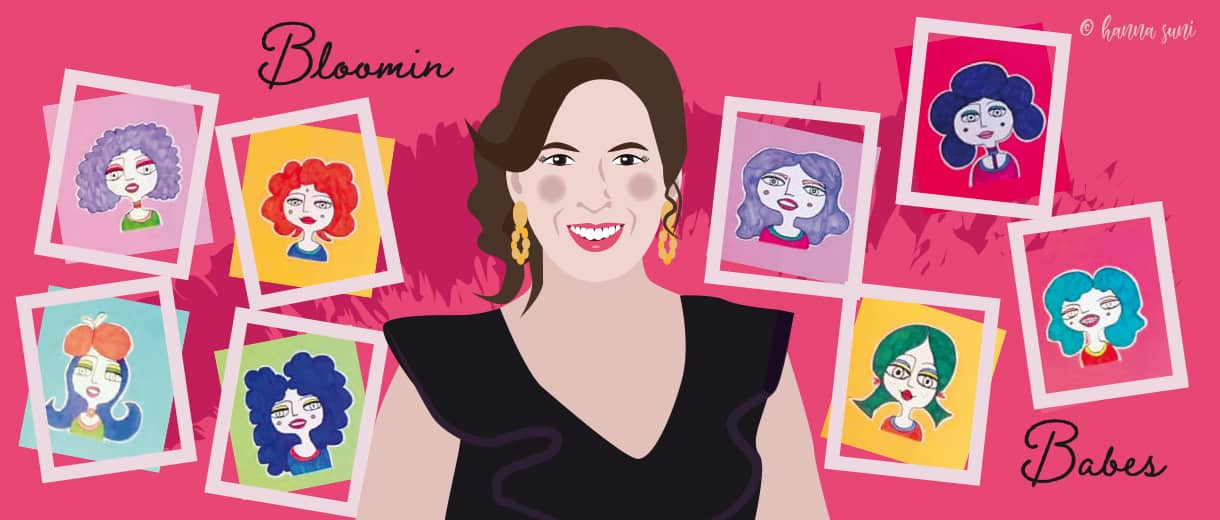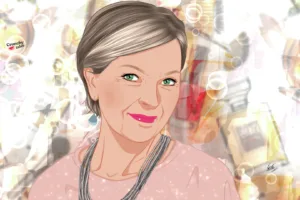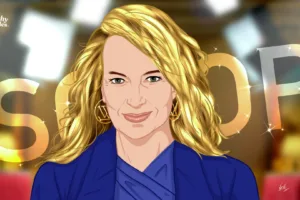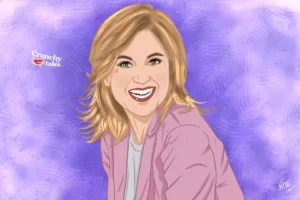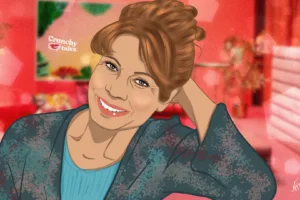Executive Fashion Director Elissa Bloom: “Today Is The Best Day Of Your Life”
There is always something glamorous and powerful about a woman wearing high heels. Elissa Bloom, Executive Director of the Philadelphia Fashion Incubator (PFI) is one of them. Stylish and sophisticated, she thrives when helping other women reach their goals and realize their passions for fashion. Through her decennial career, she has mentored and sustained countless design project launches. She firmly believes that “magic happens when we get out of our comfort zone” and while she is still eager to learn and grow as considering herself continuous work-in-progress, in midlife, she is finally tapping into her inner voice that guides her through calm and rough waters.
The Philadelphia Fashion Incubator’s mission is to ‘nurture emerging fashion entrepreneurs from Philadelphia design schools and the local fashion community’. Do your cohorts include middle-aged women and what are their strengths and weaknesses compared to their peers from other age groups?
When we first launched the program nine years ago, the cohorts mainly hosted millennials as our mission was focused on attracting recent graduates from the top Philadelphia fashion schools. However, in the past five years, we’ve started attracting more fashion entrepreneurs in their thirties, forties and fifties, many of whom are in their second- or third-careers. In this year’s cohort, three out of five students are in their midlife and have no formal fashion background: one is a former lawyer, another has a PhD in psychology and another is an ex-architect. They have launched – respectively – a women’s work boot brand for engineers and architects, a modest womenswear brand and a women’s lifestyle brand upcycling antique saris into home products, accessories and apparel. I find it so inspiring to work with these mature women who have life experience, are extremely focused and committed, and also tend to be financially more stable. I believe that because they do not have a traditional fashion background, they are much more driven to learn about their particular product category and target customer and then apply their knowledge to real-life issues. They are also more open to feedback as they haven’t experienced former critique about their business ideas and their enthusiasm is very raw and real. In comparison, the young designers in our program bring fresh ideas and energy as they are more tuned in to what is going on in the world. In the end, the cultural and demographic diversity and heterogeneity of the group creates a perfect match where every individual has lots to offer and everyone benefits and learns from each other.
With advancing climate change and other global environmental problems, sustainability is a major trend and requirement for today’s successful brands. Is sustainability incorporated in the programs at the PFI?
Sustainability has become much of a priority for designers. In our cohort this year all the designers are interested in incorporating sustainability into their business models and are very aware of all of the aspects, from where their products are being produced to how they are packaged and what impact the production cycle has on the environment. For a start-up, it is not easy to be 100% sustainable as it requires a large financial investment. But it’s been exciting to see how much emphasis and care designers are putting into these issues as they launch their businesses, incorporating sustainability into their mission, not because it is a trend, but because they truly care about the planet and future generations. 90% of our designers also manufacture locally rather than overseas where labour and production costs might be lower. I take each cohort to New York and Philadelphia for garment industry tours to encourage sustainability and local production cycles and all our designers are very committed to having a small footprint. In the US, Eileen Fisher has been in the forefront of sustainable fashion and started a strong trend in recycling where you can take your gently used garments and accessories back to the company and they will reuse them either through re-selling them after an environmentally friendly cleanse or transform them into accessories. There is also an entire global movement of upcycling your closet garments; I find it truly inspiring.
You have lived and worked both in Europe and in America. How would you define the style that American and European women have? What can they learn or adopt from the respective trends?
I’ve always been inspired by what’s going on with fashion in Europe and by how Europeans dress; the elegant, effortless style they have. I have lived in Paris and London and travelled all over Europe and it seems to me that many European women have a natural personal style and wear their original garments as well as fun accessories such as scarves, bags or hats with poise and elegance. I feel like in America people dress either very corporate or very casual – and the recent leisure-wear craze has driven people to the supermarkets and even offices in their yoga-wear. Now, with the pandemic that has confined us all to our homes, people all over the world are truly going to need a new reason to get dressed up. But there are also many older American women who are very inspiring and I’ve always admired mature women – whether in the US, Europe or elsewhere in the world – who have their own, personal style. Advanced Style, a style blog by photographer Ari Seth Cohen features beautiful women in the third act of their lives who are all such stars.
I read that you are always in heels. Is this the secret to a successful outfit? What other advice would you give to a middle-aged woman who wants to look chic or is keen on refreshing or establishing her own look? And how has your own style evolved through the decades?
I feel more comfortable wearing heels and it is a part of my personal style as I like dressing very feminine. But mine are comfort heels such as Clarks or Aerosoles, so I am definitely not sacrificing my feet wearing them. Also, I often get compliments for my defined calf muscles and I feel that I’ve developed them thanks to wearing heels. With age, I have shrunk in size, going from 5’4 to 5’3 1/2, so heels help keep me a bit taller and my posture better. I would say using creative, fun and bold accessories is a great way to style outfits that might be simple and comfortable: I personally love statement earrings, and when I have a stylish pair on and apply some lipstick and nail polish, I feel much more dressed up already. My own style has not changed a lot, but rather evolved through the years. When I was a child, my mother used to dress my sisters and I in stretchy polyester outfits that were very comfortable and even today I love dressing comfortably and wearing stretchy wrap-dresses, for example. Under my brighter, colourful dresses I will often wear black leggings. I do not like tight clothes like jeans and I’d say comfort definitely comes first, nonetheless without sacrificing my personal style.
You have mentored hundreds of women who have created a start-up in the field of fashion. What are the key things to consider when thinking of launching a new business?
Number one is you have to believe in yourself and your ideas and capabilities: if you don’t, no one else will either. You should also be honest with yourself and do a thorough SWOT-analysis identifying what you are good at and where your competitive edge might be. I would also say do not try to do it alone, but put together a team and bring in people that can support you on your business journey. When I launched my accessories brand, Elissa Bloom New York, many friends helped me out, one writing copy for my website and catalogues, another with the website design, a third friend connected me with a PR person and in the end, it almost felt magical that my focused intention brought together all these people who wanted to give a hand. If you cannot hire people because of a low budget, think of relatives and friends that can pitch in for free or eventually become supporters of your project and brand. You should also keep in mind that you are going to have both successes and failures, so it is important to learn to embrace both, as well as to learn to live with some fear. Make fear your friend, so that it can become a positive driver for you to take action, even if just small steps, going forward every day with determination.
In a presentation you gave in Rome in you said that fashion – like any other commercial idea – needs to serve a purpose and fill a void in the market. What kind of research is needed to define new or existing voids that need to be filled?
It is important to realize that most things have already been invented and it is not easy to come with a completely new product or service ideas. In fact, choreographer Twyla Tharp says that what really matters is how you are going to take what already exists and make it your own, giving it your personal creative voice. Success is most often celebrated when designers bring something – an existing product or service idea – to the market that is seen in a brand new, creative way.
As for clothing, I would say that functionality is hugely important, especially in times like this when people are very discretionary with their spending and would rather spend on non-tangible goods things such as experiences and travel or on electronics. So when fashion designers launch new ideas really they have to make sure that the fit is good and the garment is functional. They also need to do thorough research in understanding their customers’ needs and product development before the launch.
You say that building a brand is not a quick race but rather a marathon – it takes time, perseverance and patience. According to your experience, how long does launching a successful brand approximately take?
A lot of it has to do with creating a community, targeting your customers and getting them engaged with your brand because it is not just about selling a product or service but making connections: we all want to feel part of something and engaging your customers and making the whole selling and buying process interactive makes such a difference. Storytelling is a great way to get the customers involved: you can share your entrepreneurial journey with them, showing pictures of the manufacturing process, sharing your successes and failures and asking your customers which products they like the best. I would say it takes a minimum of three to five years to really build brand recognition in a market whereas gaining long-term, durable popularity. Success takes even longer: from five to ten years. If you are planning on launching a new brand, it is important to realize that half the battle is in giving up on your project or idea. Be prepared to grant yourself time and evaluate your progress well along the way. Every six months it is useful to have a moment of self-evaluation, checking where you are at, celebrating your successes, acknowledging your failures and planning your business goals for the next six months. It is also important to recalibrate often: if you realize things are not going as planned, it is also perfectly fine to pivot and take a different direction.
Midlife is a moment in which we would love to explore new paths but at the same time, we find it difficult to leave our comfort zone. What would you suggest to women feeling stuck in the middle of their journey?
I have a strong, inspiring image printed on my wall that depicts a small, tight circle and then a larger, brighter one and reads: “Magic happens when we get out of our comfort zone”. It is hard to do because we easily get into a safe, comfortable routine, but it is when we are really honest with ourselves and put ourselves out on a limb that we can grow and reach important results, improve our lives and be truly satisfied. So ask yourself “how can I remain curious and have fun”? Whether it is exploring a new career or starting a hobby, think about what energizes you and gets you excited. Aim at being bold and do research, talk with people, find out more about what gets you ticking. I would say you first need to gather information and figure out what is it exactly that you want to do and then slowly start planting seeds to go in that direction. I once heard a networker say that we should ideally reach out to three people in our network every day, to touch base, discuss new ideas or to check up or get an honest second opinion. Networking is extremely important. Most of the jobs or projects along our careers don’t come through sending resumes, but rather from our network and the proposals that we pick up and accept along the way. So be open and don’t be afraid to ask for an introduction if you “know someone who knows someone”.
What has been your biggest midlife revelation?
I am definitely a work-in-progress. At my age, I know what inspires me: being able to help, sustain and encourage emerging designers. But I am also extremely passionate about secondary fashion sectors around the world. Luckily I have had the opportunity to share my knowledge and expertise on fashion entrepreneurship with the US State Department and my trips to Europe, Asia and Africa have made me realize that I love working with fashion sectors in these secondary markets. So many incredibly talented designers and many women who I have met in my travels that are making an impact in their communities. Last year in Italy I worked with women refugees and supporting them, giving them guidance on their business model and designs which was rewarding. At times I find myself thinking: what do I actually have to contribute? But then I realize there is so much experience and expertise in each one of us that others can find useful and can make a difference in their lives. Whether it is through my own designs that inspire someone or through my knowledge in launching fashion brands, I am really excited about each opportunity and feel like there is so much more to discover and I am just scratching the surface of this new chapter of my life. Certainly, when I was younger, I was more free and fearless, but even now I feel a strong inner angst to explore more and continue to develop my skills and follow my passion.
Your motto is: Today is the best day of your life. Stay present and curious. Are you able to apply it in your life?
I work on it every day. Tao Porchon Lynch was the oldest yoga teacher in the world who passed away last year, at the age of 101. I took a yoga class with her four years ago in New York and I remember her saying: every day is the best day of your life. I just love that and repeat it to myself and my 10-year-old son every morning. It helps me live in the present, even though it does take a lot of mindfulness and it is not easy or even possible to live every day as if it was the best.
But I must say that Midlife – and the Pandemic – have helped me realize what is most important to me and taught me to let go of things that I thought were important but no longer support me. I’d say it is crucial to set your priorities and to think of the quality life that you want to live and the people you want to have in your life. Also, being more discerning with your time and not saying ‘yes’ to every single proposal that comes our way. As women, we are always a work-in-progress, but with time we learn to tap into our own inner wisdom and higher selves that are all-knowing and intuitive. If we only manage to be quiet and listen to that voice and trust it as well, we are on the right track.
Like this article? Sign up to our newsletter to get more articles like this delivered straight to your inbox.

